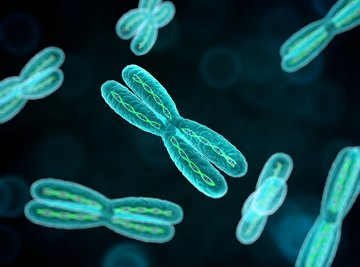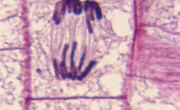
Practically everyone with any exposure to pop culture and its crime dramas, let alone science, has heard of DNA, or deoxyribonucleic acid. And even those who don't know what the letters stand for – deoxyribonucleic acid – have a notion that DNA is something of a microscopic fingerprint, with every one of the planet's billions of humans carrying a unique form of this mysterious material. Similarly, most folks of a certain age know that DNA is the "something" parents pass along to their offspring to make family traits what they are.
While most of these same people have likely heard of chromosomes, however, comparatively few people can describe exactly what these are, where they're found and what their purpose is. In fact, a chromosome is nothing more than one very long strand of DNA (called chromatin) bound to a protein called histones. These "live" in the nucleus of your cells, and they are responsible for organizing and transmitting genetic information.
Definition of a Chromosome
Chromosomes are threadlike containers of genetic information that inhabit the nuclei (singular: nucleus) of cells. Living things consist almost entirely of prokaryotes, almost all of which are bacteria, and eukaryotes, which are animals, plants and fungi. Only eukaryotes have nuclei, and so the genetic material of bacteria, which like that of all living things consists of DNA, exists in the cytoplasm of bacteria cells as a singular, ring-shaped "chromosome."
Humans have 23 pairs of chromosomes in every cell except for the gametes, which are the "sex cells" that fuse to form "typical" cells in the process of reproduction. These 23 pairs include 22 pairs of chromosomes simply numbered 1 through 22 and a pair of sex chromosomes, which are X and Y in males and X and X in females. Each chromosome in a pair, one of which comes from the mother and the other of which comes from the father, is structurally almost identical to the other member of the pair, but distinct from the other numbered chromosomes and the sex chromosomes; these are known as homologous chromosomes.
Right after a cell divides along with every one of its chromosomes, it contains a single copy of all 46 of its individual chromosomes. This single copy is called a chromatid. But soon afterward, each of these chromatids undergoes replication, thereby creating an identical copy of itself. This is a step in preparing a young cell for a division of its own in the near future. After all, if a cell is going to divide into two identical daughter cells, everything inside it, both inside and outside its nucleus, needs to be replicated with great precision.
DNA and Nucleic Acid Basics
DNA is one of two so-called nucleic acids in the biology world, and is far more notorious than its comrade ribonucleic acid (RNA). Nucleic acids consist of polymers (which can grow extremely long) of units called nucleotides. Each nucleotide consists of a five-carbon sugar, a phosphate group and one of four nitrogen-rich bases. In DNA, the sugar is deoxyribose, while in RNA, it is ribose. Also, whereas DNA nucleotides contain one of the four bases adenine, cytosine, guanine and thymine, in RNA, uracil is substituted for thymine. DNA is double-stranded, with the two strands bonded at each nucleotide by nitrogenous bases. Adenine (A) pairs with and only with thymine (T), while cytosine (C) pairs with and only with guanine (G). The differences between DNA molecules are what account for genetic variability between people, and these differences are entirely result of the fact that each nucleoside can have one of four bases, making for a virtually limitless number of combinations in a long molecule.
A string of three bases (or equivalently for present purposes, three nucleotides) is called a triplet codon. This is because each three-base sequence carries the "code" for making a single amino acid, and amino acids are the building blocks of protein. Thus A-G-C is a codon, A-G-T is another codon and so on for all 64 possible three-base codons made from four different bases in all (43 = 64). There are 20 total amino acids used to make proteins in humans, so 64 unique triplet codons is more than enough, and in fact, some amino acids are made from two or even three different codons.
The information is encoded in RNA made from DNA in a process called transcription that occurs in the nucleus, while process of making proteins from RNA is called translation and takes place in the cell cytoplasm after newly transcribed RNA moves outside the nucleus.
Parts of a Chromosome
Each chromosome in its non-replicated state consists of a single chromatid, which is simply a very long DNA molecule to which are attached a great many histone protein molecule complexes. Each of these complexes is an octamer made from four subunits, each containing a pair of histone subtypes. These histones are rather like spools, and the DNA in chromosomes winds around the histone close to twice before moving on toward the next octamer. Each local histone-DNA array is called a nucleosome. These nucleosomes warp and coil and twist themselves so tightly that while a completely straightened chromatid would be about 2 meters long, every chromosome instead fits into a cell less than a millionth of a meter across.
Histones make up about 40 percent of every chromosome by mass, and DNA accounts for the other 60 percent. While histones are regarded mainly as structural proteins, the manner in which they allow and force coiling and supercoiling of DNA renders certain spots along the DNA molecule especially convenient for other molecules to interact with. This in turn can influence which genes in the DNA (a gene being all of the DNA codons that contain the information for a given protein product) are most active or most suppressed.
When chromosomes replicate, the two resulting identical chromatids are joined by a structure called a centromere, which is usually not at the center of each linear chromatid, but substantially to one side. The longer segments of the paired ("sister") chromatids are called the q-arms, while the shorter segments are dubbed p-arms.
Chromosome Reproduction
Chromosomes reproduce by a process called mitosis, which is also the name for the division of the cell as a whole. Mitosis is asexual reproduction, and results in two identical chromosome sets. The other kind of chromosome reproduction, meiosis, is reserved for reproductive processes resulting in a new organism and is not discussed here.
Mitosis, which is similar to the binary fission that splits bacteria into two identical daughter bacteria (these organisms consist of just one cell, so cell reproduction in prokaryotes is the same as whole-organism reproduction), consists of five phases. In the first, prophase, the chromosomes become super-condensed as the histones do their jobs, preparing the molecules for division. In prometaphase, the membrane around the nucleus disappears, and the structures that make up the mitotic spindle apparatus, mostly microtubules, "reach in" from either side of the cell toward the chromosomes that have begun migrating toward the middle of the cell in a line. In metaphase, the mitotic spindle manipulates the chromosomes into a near-perfect line, with sister chromatids on either side of it. In anaphase, which is brief but a wonder to behold under a microscope, the spindle pulls the chromatids apart from their centromeres. Finally in telophase, new nuclear membranes form around the new chromosomes sets, and new membranes are put in place around the two new daughter cells as well.
References
- Scitable by Nature Education: Replication and Distribution of DNA During Mitosis
- National Human Genome Research Institute: Chromosomes Fact Sheet
- U.S. National Library of Medicine: Genetics Home Reference: What Is a Chromosome?
- University of Leicester: Virtual Education Center: DNA, Genes and Chromosomes
About the Author
Kevin Beck holds a bachelor's degree in physics with minors in math and chemistry from the University of Vermont. Formerly with ScienceBlogs.com and the editor of "Run Strong," he has written for Runner's World, Men's Fitness, Competitor, and a variety of other publications. More about Kevin and links to his professional work can be found at www.kemibe.com.
